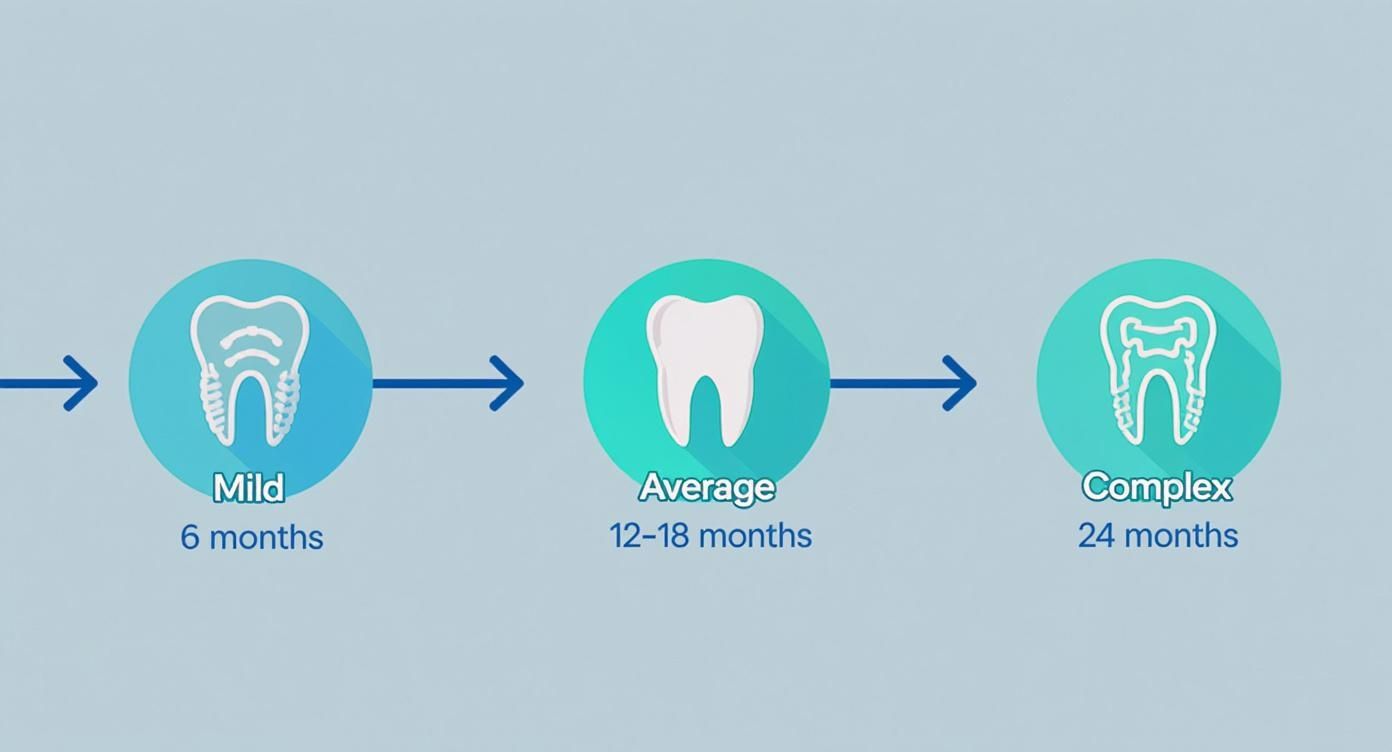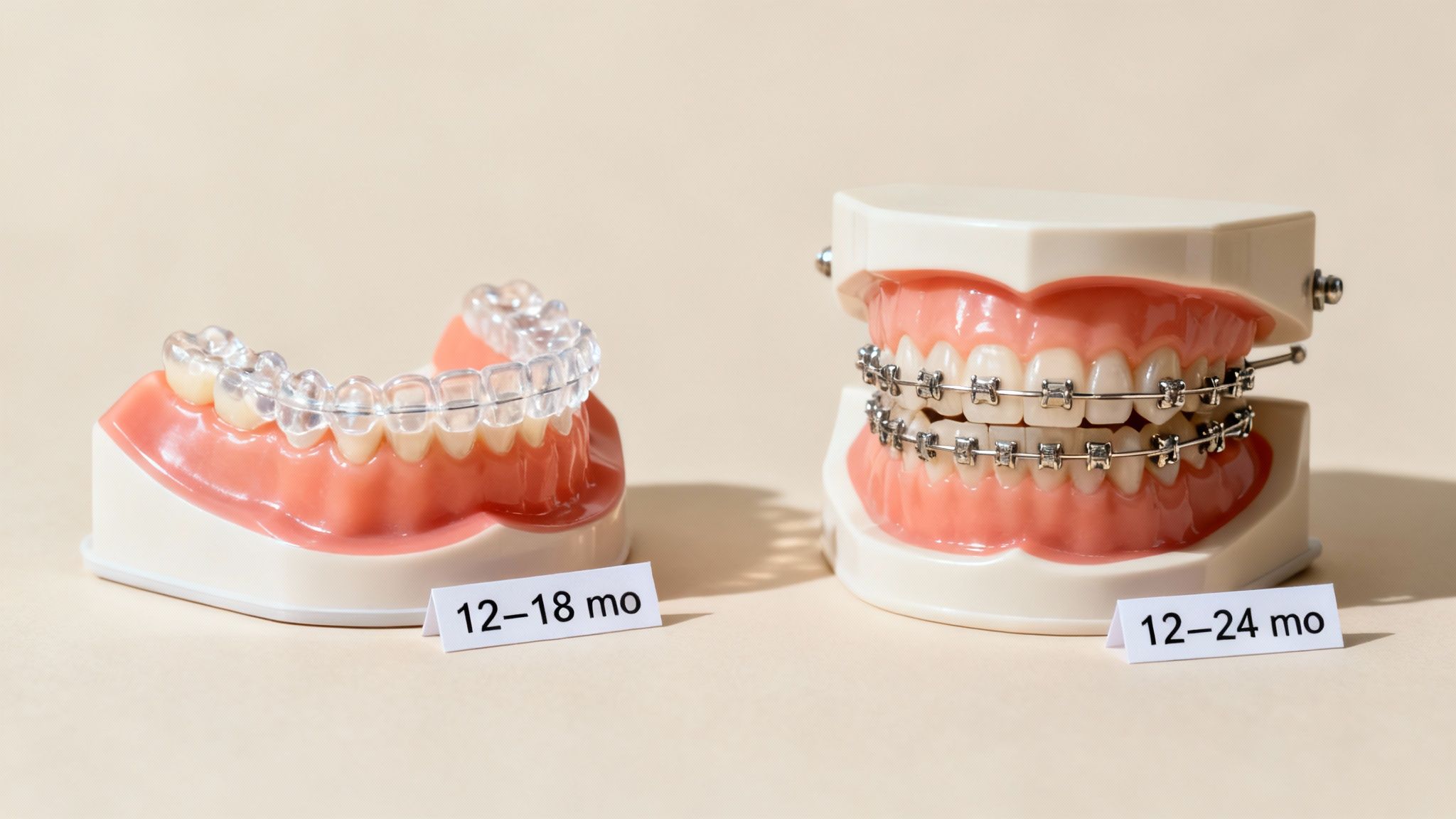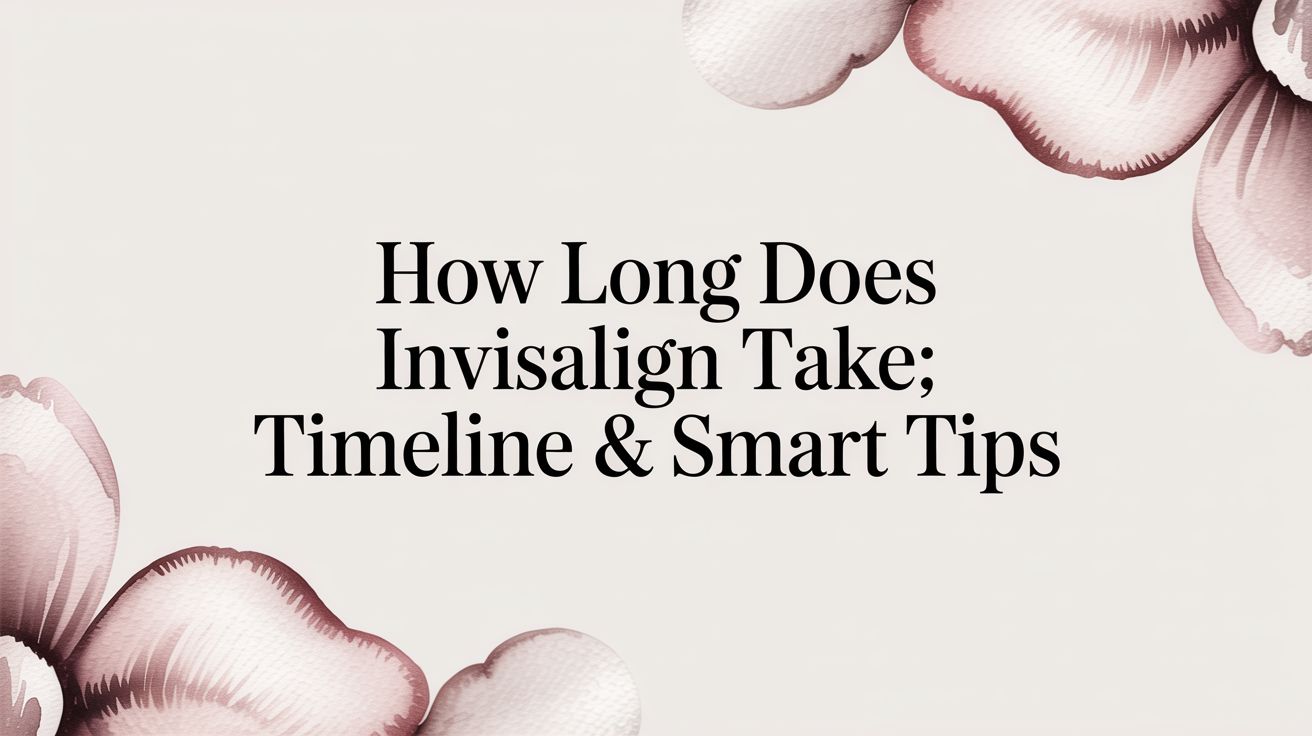Wondering how long Invisalign takes to work? It’s the most common question, and the answer is that most people complete their treatment in 12 to 18 months.
Of course, this is an average. Simpler cases, like minor adjustments, can be finished in as little as 6 months. More complex orthodontic issues, on the other hand, might require up to 24 months to achieve the best results.
Setting Expectations for Your Invisalign Timeline
To make your Invisalign journey successful, it helps to know what to expect. Think of your treatment like a road trip to your ideal smile. A short trip to fix a couple of slightly crooked teeth is a quick drive across town. A major bite correction is more of a cross-country journey. The vehicle—Invisalign—is the same, but the distance your teeth need to move determines the length of your trip.
This isn’t just a guess. It’s based on data from over 18 million Invisalign users worldwide. Year after year, the vast majority of treatments fall into that 12-to-18-month range. Decades of technological refinement have made these timelines highly predictable, a point often highlighted in dental industry treatment statistics.
Breaking Down Timelines by Case Complexity
To give you a clearer idea of your potential timeline, let’s break it down by the complexity of the orthodontic work required.
- Mild Cases (6-8 months): Best for minor cosmetic adjustments. This includes slight spacing, minimal crowding, or correcting teeth that have shifted slightly after previous orthodontic work.
- Moderate Cases (12-18 months): This is the most common scenario. It addresses more noticeable issues like moderate crowding, significant gaps, and common bite problems such as overbites or crossbites.
- Complex Cases (18-24+ months): For more significant orthodontic corrections. These cases often involve correcting a major bite issue, addressing severe crowding, or rotating teeth that are significantly out of position.
Let’s organize that into a quick-reference table.
Invisalign Treatment Timelines at a Glance
This table provides a simple overview of what to expect based on the level of correction your smile needs.
| Case Complexity | Estimated Treatment Time | Common Issues Addressed |
|---|---|---|
| Mild | 6–8 months | Minor crowding, small gaps, slight relapse from prior braces |
| Moderate | 12–18 months | Noticeable crowding/spacing, overbite, crossbite |
| Complex | 18–24+ months | Severe crowding, significant bite correction, major rotations |
While this table is a useful guide, your timeline is ultimately unique to you.
Your personal timeline is a combination of your dental needs and your commitment. The single most important action you can take to stay on schedule is to wear your aligners consistently.
We eliminate all guesswork at your initial consultation. Using a 3D scanner, we create a precise digital map of your mouth and build a personalized plan that shows you every step. That’s when you’ll get the exact answer to how long your journey will take.
Your Invisalign Journey from Start to Finish
Starting Invisalign treatment can feel like a big commitment, but the process is a series of clear, manageable steps.
Think of it like planning a project. You don’t just start; you define the goal, map out the steps, execute the plan, make adjustments, and finally, achieve the desired result. Each phase gets you closer to your new smile.
Let’s walk through the entire experience, from the first consultation to the final reveal.
Step 1: The Initial Consultation
Your journey begins with a conversation. The first visit is to determine if Invisalign is the right tool for your goals. We’ll examine your teeth, discuss what you want to achieve, and provide an initial estimate of how long Invisalign will take for your specific case.
This is your opportunity to ask questions, understand the process, and get a professional opinion on whether clear aligners can deliver the results you’re looking for.
Step 2: Digital Scanning and Treatment Planning
Once you decide to proceed, we use advanced technology to map out your treatment. We use a high-tech 3D scanner to create a precise digital model of your mouth in minutes—no messy impressions needed.
This digital blueprint is the foundation of your plan. It allows us to design your tooth movements and even show you a virtual simulation of your final smile. You’ll see the end result before you even start. This is also when we finalize your exact treatment timeline.
This infographic provides a great overview of typical timelines.

As you can see, while some cases finish quickly, most people fall into the 12-to-18-month range. More significant corrections will require more time.
Step 3: Wearing Your Aligners
This is the active phase where you take control. You’ll receive a series of custom-made, clear aligners. Each set makes small, precise adjustments to your teeth. You will switch to a new set every one to two weeks, as directed by your dentist.
The key to success is consistency. To work effectively, you must wear your aligners for 20 to 22 hours per day. You’ll remove them only to eat, drink anything other than water, and for oral hygiene. This quickly becomes a simple part of your daily routine.
Step 4: The Refinement Period
Sometimes, a few teeth need an extra nudge to get into their final position. This is the purpose of the refinement phase. After you complete your initial series of aligners, we’ll assess your progress.
If final tweaks are needed, we’ll take a new scan and order a few additional aligners to perfect the details.
Actionable Insight: View refinements as a standard part of the process—it’s like the final quality check to ensure your smile is perfect.
This is quite common. Recent data shows the average Invisalign treatment lasts from 6 to 22 months, and a 2025 study found that 72% of Invisalign patients required refinements to achieve their ideal outcome. For more details, you can find more treatment insights here.
Step 5: The Retention Phase
Congratulations, your teeth are straight! Now, the crucial phase begins: retention. To protect your investment and prevent your teeth from shifting back, you must wear a retainer.
Initially, you’ll likely wear your retainer full-time, similar to your aligners. Over time, you will probably transition to wearing it only at night. This is a lifelong commitment, but it is the only way to ensure your smile remains as straight as it was on the day your treatment ended.
Key Factors That Influence Your Treatment Time
While the average Invisalign treatment is 12 to 18 months, the real answer to “how long will my treatment take?” is always personal. Your dental situation and daily habits are the two main variables that shape your timeline.
Think of it like personal training. Your workout plan will differ from a friend’s based on your starting fitness, how your body responds, and your consistency. Your Invisalign journey is defined by a similar combination of factors.
Let’s break down what determines your personal timeline.
The Complexity of Your Case
This is the most significant factor. The amount of movement your teeth require directly impacts how long the process will take. Closing a small gap is a short jog; correcting a complex bite is a marathon.
Each aligner is engineered to make a precise adjustment of about 0.25mm. The more movement needed, the more aligners you’ll require, extending your treatment time.
Certain issues inherently require a longer timeline:
- Severe Crowding or Spacing: Teeth that are tightly packed or have large gaps have a greater distance to travel.
- Major Bite Correction: Correcting an overbite, underbite, or crossbite involves moving entire arches of teeth.
- Significant Tooth Rotations: Turning a twisted tooth requires steady, consistent pressure over a longer period.
- Extractions: If a tooth must be removed to create space, a portion of your treatment will be dedicated to closing that gap, adding to the overall duration.
Data supports this. Studies show that cases with mild crowding average 13.4 months, moderate cases average 15.9 months, and severe issues can take 17.9 months or longer. You can review some of the specifics of these orthodontic findings for more information.
Your Commitment to the Plan
While you can’t change your starting point, this next factor is 100% within your control. Your dedication is critical to finishing on time. Invisalign aligners only work when they are in your mouth applying gentle, constant force.
The rule is non-negotiable: wear your aligners for 20 to 22 hours a day. Anything less pauses your progress.
Forgetting them for a few hours may seem insignificant, but this time adds up. If you consistently miss the 22-hour mark, your teeth won’t track with the plan. This can cause your next aligners to fit improperly, requiring a mid-course correction that can add weeks or even months to your timeline.
Your Age and Biology
Your body’s natural processes also influence the timeline. Teenagers and young adults typically have less dense, still-developing bone, which allows teeth to move more quickly.
In adults, the jawbone is fully mature and denser, so the same movements may take longer. This doesn’t mean Invisalign is less effective for adults—it is highly successful—but the timeline might be slightly longer compared to a teen with identical dental issues.
How Your Body Responds
Finally, there’s your unique biological response. Everyone’s teeth move at a different pace, influenced by genetics, tooth root shape, and jawbone density.
This is why two people with identical plans and perfect wear time might see slightly different rates of progress. We anticipate this by monitoring how your teeth are “tracking” at each check-up, ready to make any necessary adjustments to keep your treatment moving forward efficiently.
How to Keep Your Invisalign Treatment on Track
While your dentist creates the treatment plan, you are in control of its execution. Your daily habits directly impact how long Invisalign will take. By taking an active role, you can prevent common delays and ensure a smooth journey.
Here are actionable steps you can take to stay on schedule and partner in creating your new smile.
Master the 22-Hour Rule
The most critical factor you control is wear time. Aligners must be in your mouth for 20 to 22 hours daily to apply the continuous pressure needed to move your teeth. Falling short is the primary cause of treatment delays.
Here are three actionable tips to hit that 22-hour target:
- Set Reminders: Use your phone to set alarms for 15-20 minutes after meals to remind you to put your aligners back in.
- Use a Timer: When you remove your aligners to eat, start a timer. This visual cue helps you stay accountable for your “out” time.
- Create a Habit Loop: Make it a rule to re-insert your aligners immediately after brushing your teeth. This links the new habit to an existing one.
Keep Your Aligners Safe and Clean
A lost or broken aligner can set you back several weeks while you wait for a replacement. The best way to prevent this is to use your case every single time.
Never wrap your aligners in a napkin—it’s the fastest way to lose them. The moment your aligners come out of your mouth, they go into their protective case. Keep the case with you at all times.
Actionable Insight: A clean aligner prevents complications. Good hygiene stops plaque buildup that can cause bad breath, cavities, or gum irritation—all of which can disrupt your treatment.
Maintaining excellent oral hygiene is essential. A solid routine is the foundation of successful orthodontic treatment. For more on how daily habits protect your smile, Olara Dental offers valuable information on preventive dentistry.
Stay on Schedule with Aligner Changes
Your treatment is a carefully sequenced plan. Switching to your next aligner on the correct day maintains momentum. Changing too early can harm your tooth roots, while changing too late adds unnecessary time to your treatment.
Actionable tip: Use a digital calendar or a physical one to mark the date for every aligner change. This simple organization removes guesswork and ensures each tooth completes its programmed movement before starting the next phase.
Invisalign vs. Braces: How Do Timelines Compare?

When choosing how to straighten your teeth, a key consideration is time. How does the Invisalign timeline compare to traditional metal braces?
The answer depends on the complexity of your case. For many people with mild to moderate issues, like minor crowding or small gaps, Invisalign can be just as fast as braces, and sometimes even faster.
However, for more complex situations, traditional braces may have an advantage. Certain movements, like correcting a severely rotated tooth or making significant vertical shifts, can sometimes be handled more efficiently by the direct force of brackets and wires.
Key Differences in the Day-to-Day Experience
Your treatment timeline isn’t just about the total duration; it’s also about how it integrates into your life.
With braces, you’ll have adjustment appointments every 4 to 8 weeks. These visits are mandatory for your orthodontist to tighten wires and keep your teeth moving.
Invisalign typically requires fewer office visits. You’ll receive several sets of aligners at once and only need a check-up every 6 to 12 weeks, a significant benefit for busy schedules.
The key trade-off is personal responsibility. Braces work 24/7. With Invisalign, the timeline’s success depends entirely on you wearing the aligners for 20-22 hours a day.
A Head-to-Head Comparison
This table breaks down how the two options compare in terms of time and lifestyle impact.
Treatment Timeline: Invisalign vs. Traditional Braces
| Feature | Invisalign | Traditional Braces |
|---|---|---|
| Average Time | 12–18 months | 18–24 months |
| Best For | Mild to moderate crowding, spacing, and bite issues | Complex cases, severe rotations, or cases requiring extractions |
| Appointment Frequency | Every 6–12 weeks | Every 4–8 weeks |
| Lifestyle Impact | Removable for eating; no dietary restrictions | Fixed in place; requires avoiding certain hard or sticky foods |
| User Responsibility | High (you must wear them 20–22 hours daily) | Low (your orthodontist handles all adjustments) |
Ultimately, the best choice depends on a professional evaluation of your unique dental needs. For some, the potential for a faster treatment and the convenience of removable aligners make Invisalign the clear winner. For others with significant orthodontic challenges, the power of braces offers a more direct solution.
A consultation is the only way to determine the most effective and efficient path for you.
A Few More Questions About Your Invisalign Timeline
Even with a detailed plan, questions can arise. Here are actionable answers to some of the most common concerns we hear.
Can You Speed Up Your Invisalign Treatment?
Everyone wants to finish faster, but the answer is no—you cannot safely rush biology. Your treatment plan is designed to move teeth at a specific, safe pace.
Trying to skip ahead to the next aligner set before schedule will not speed up your treatment. It can cause significant pain, damage tooth roots, and disrupt your progress, potentially adding more time to your treatment.
Actionable Insight: The fastest way to finish Invisalign is to follow the plan perfectly. Wear your aligners for 20-22 hours daily and change them on the exact day recommended. This is the only “secret” to finishing on time.
What Happens If You Forget to Wear Your Aligners for a Day?
Life happens. Forgetting your aligners for a day is not a disaster, but you need to take immediate action to get back on track. Your aligner will likely feel tight when you put it back in—a sign your teeth have already started to shift.
If this happens, here’s your action plan:
- Put your current aligners back in immediately.
- Wear that set for an extra 24-48 hours past your scheduled switch day to allow your teeth to catch up.
- Do not advance to the next set to make up for lost time.
If you haven’t worn them for several days and they no longer fit, do not force them. Call your dentist right away. They will provide instructions, which may involve temporarily reverting to your previous set of aligners.
Why Do Treatment Times Differ for Adults and Teens?
Age is a significant factor in how long Invisalign takes. Teenagers often complete treatment faster than adults for one reason: their jaws are still growing.
A teenager’s bone is more pliable, allowing teeth to be guided into position more easily. An adult’s jawbone is fully mature and denser, so moving teeth through it requires more time. Invisalign is highly effective for adults, but the process must be gradual to achieve the same excellent, lasting results.
Have more questions? Find more answers on our comprehensive FAQ page.
Your Invisalign Journey Starts in Bellaire
Now that you understand the factors influencing your Invisalign timeline, the next step is personal. While averages are helpful, the only way to get a definitive answer for your smile is through a professional consultation. This is where you move from estimation to a clear, customized action plan.
At Olara Dental, we use state-of-the-art 3D imaging to map out every step of your treatment. We are proud to serve the Bellaire community, helping our neighbors achieve the smiles they’ve always wanted on a predictable schedule. Stop wondering how long Invisalign will take and get a precise answer.
Our experienced team will build a plan that fits your unique needs. To learn more about our approach, check out our guide to getting Invisalign in Bellaire, TX. Taking the first step provides clarity and confidence.
Your ideal smile is closer than you think. A personalized consultation provides the exact timeline and treatment plan needed to transform your smile with confidence and precision.
Ready to find out your exact Invisalign timeline? Get in touch with Olara Dental today to schedule your personalized consultation and get started.

